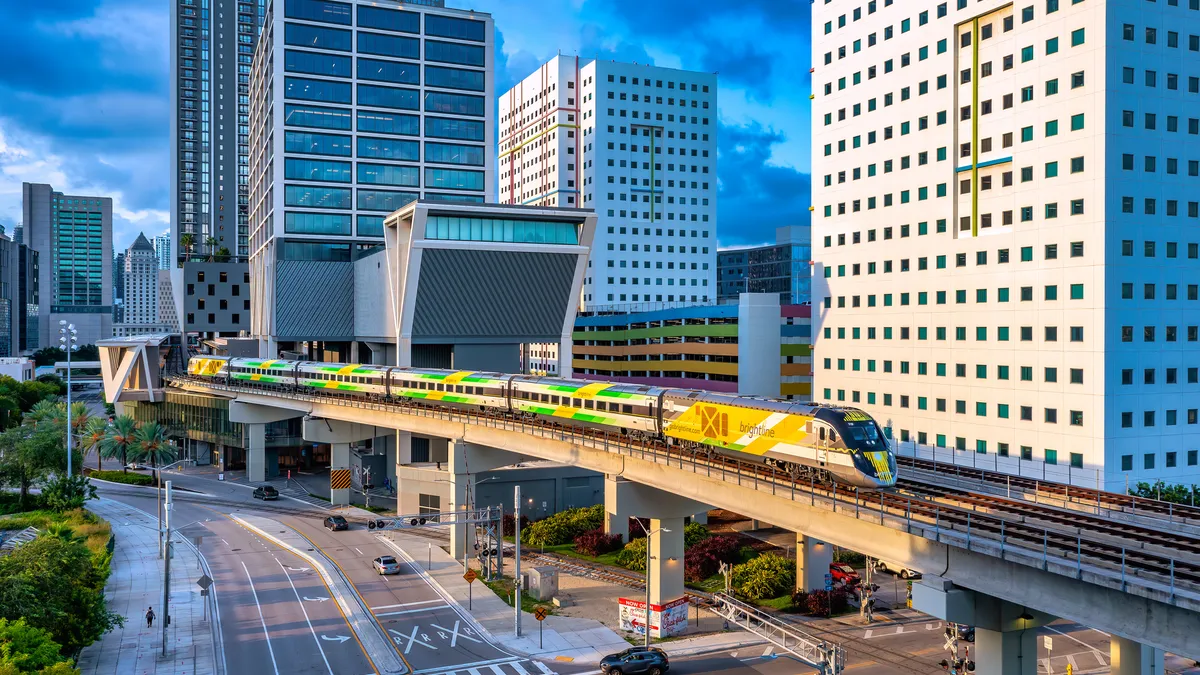High-speed rail projects tend to entail challenges that can cause delays, controversy and cost overruns, according to new research from AECOM, but there are ways to execute them smoothly.
The Dallas-based contractor’s report delves into industry trends and how to make these notoriously challenging projects successful. It is based on a survey of 112 senior decision-makers involved in high-speed rail projects around the world.
The growth of rail is key to decarbonizing the transportation industry, and the report expects such projects to boom in coming years. Yet U.S. rail projects typically take longer to complete and are more expensive than similar ones built in other countries, separate analysis from the Eno Center for Transportation found. That’s in part because U.S. public transit agencies rarely have the structure, authority or experience to deliver a major transit construction project.
Unique obstacles
Another challenge is that rail construction is often spread over longer timelines than other megaprojects, and this extended duration brings risks, according to the AECOM report. Political parties change and public opinion can shift as rail lines are developed.
The H2 project in the U.K. is an example of a project falling victim to political changes — new Prime Minister Rishi Sunak canceled the effort when he took office last year, citing ballooning costs and mismanagement.
Plus, inflation is hitting these projects especially hard, causing them to go over budget and hampering expansion. In fact, 73% of survey respondents in AECOM’s report worry that the rising cost of construction, equipment and materials could stop projects already in progress.
And funding is another major concern, as cost overruns have derailed high-speed rail projects. A notable U.S. example is California’s bullet train, which now has a funding gap of more than $100 billion, jeopardizing its full buildout and therefore its full utility.
Other major issues include land acquisition, property rights and disputes over right of way. There will inevitably be people who, while in favor of the idea of high-speed rail, are unhappy about the way in which specific proposals affect them, per the report, as well as those who lack awareness of the benefits.
The report also noted that complex approval and permitting processes can lead to delays and extra costs.
Best practices
While every high-speed rail project is unique, the successful ones do have throughlines. AECOM’s report highlighted several best practices to streamline delivery:
- New funding models.
- Greater regional and international cooperation.
- Long-term decisive political leadership.
- New design and construction.
- Increased collaboration and industry outreach.
- User-centric design and engagement.
- Design-to-cost and disciplined cost control.
Rail construction evolving
While many of these elements are out of builders’ hands, some are within their control. In fact, 79% of respondents are excited about the prospects for new construction methods, which can reduce the time and cost required to get high-speed rail projects operational.
Examples include modular construction methods, standardization for key elements and more advanced machinery for tasks such as tunneling. Tunnels are being constructed using the cut-and-cover method, and the use of prefabricated arches have helped to save time, costs and carbon, according to the report.
In five years’ time, the top two most impactful innovations are expected to be energy-efficient design and low-carbon materials, which can further enhance the positive environmental impact of rail projects.
“One of the things I’m most excited about is that we’re looking to operate entirely on renewable power,” said California High-Speed Rail Authority CEO Brian Kelly in the report. “We have land in the rights-of-way parcels to host solar facilities, which will also mean we can offer our service without taxing the power grid.”
How to better build rail
The question of how to fund high-speed rail infrastructure looms large in light of its massive up-front cost. Public funding remains key, but there are also successful examples of private funding for these projects, such as the Brightline rail in Florida and coming soon to connect Los Angeles and Las Vegas.
Brightline illustrates the importance of leveraging existing transportation corridors to expedite land acquisition and permitting while also reducing costs. Public-private partnership models often bring a deeper degree of financial rigor in adhering to project budgets, the report notes.
It is also vital to get land rights resolved before moving ahead with projects, report authors said. Strong government leadership, including planning, management and policy, is essential for success. Successful projects tend to shift opinions, easing the way for the development of new lines and additional capacity.
“Big ideas and plans only get you so far. To get past that inflection point where the trajectory of growth shifts significantly, you have to have people enjoying the high-speed rail experience. You have to demonstrate the benefits,” said Brightline CEO Michael Reininger in the report.




















